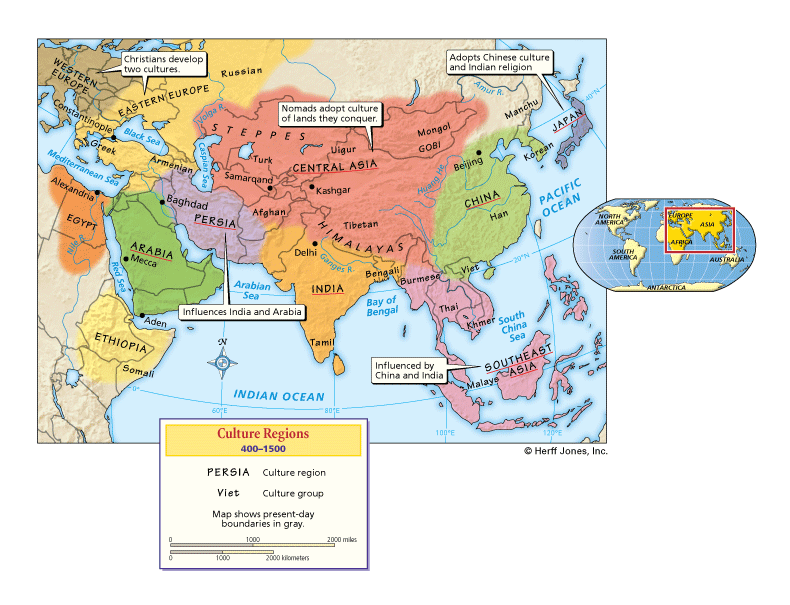
The Arabian Peninsula had long been at the edge of Mediterranean and Persian civilizations. The region was divided into tribal areas in the deserts, small kingdoms on the southern coast, and provinces of the Byzantine and Persian Empires to the north and west. Christianity, Judaism, and traditional polytheism were all practiced in the area at the beginning of this era. Islam emerged from this region beginning in 622 and became a major world religion, and the main religion in the region.
Persia was a major empire since the defeat of the Seleucids back in 235 B.C. A new Persian empire, the Sassanids, ruled much of the Middle East until Muslim armies defeated them in A.D. 651. After that Persia became part of various Muslim kingdoms and empires. At the beginning of this era, Persia was mainly Zoroastrian with Jews and some dissident Christians living in the region. At the end of this era, Persians were mainly Muslim, with a smaller number of Jews and Christians.
India was mainly made up of medium-sized kingdoms occasionally conquered by empires including the Guptas at the beginning of this period and the Mughals at the end of this period. At the start of this period, Hinduism and Buddhism were the main religions of the region. Buddhism declined in this period except in Sri Lanka. Islam, introduced about 1000, became an important religion in northern India by 1500.
Central Asia was mainly a tribal area with some city-states and kingdoms in the south until the 1200s, when the Mongols conquered a massive empire. In 400, Central Asians practiced Buddhism in the south, modified Zoroastrianism (Manichaeism) among scattered ethnic groups, and traditional religions sometimes called shamanism. In 1500 Buddhism was the dominant religion in the east and Islam in the west with shamanism surviving in the far north or practiced with Buddhism.
The Chinese Empire was restored in 581 with the Sui dynasty. China remained largely unified throughout this period. Traditional Chinese religion, combined with the philosophies of Taosim and Confucianism, was the dominant belief of China. Buddhism also combined with these beliefs. With one major exception, the different beliefs were practiced peacefully side-by-side.
Japan was developing a unified empire during much of this period. The Japanese practiced Shintoism, their traditional religion, and combined it with Buddhism after 552. They also added some ideas from Confucianism and Taoism into their traditional beliefs.
Southeast Asia was ruled by several different kingdoms and empires during this era. Throughout much of this period, the people in the region were Hindu or Buddhist. In about 1200 Islam was introduced to the coastal areas of the region, leading to the growth of the Muslim communities particularly among the Malays.